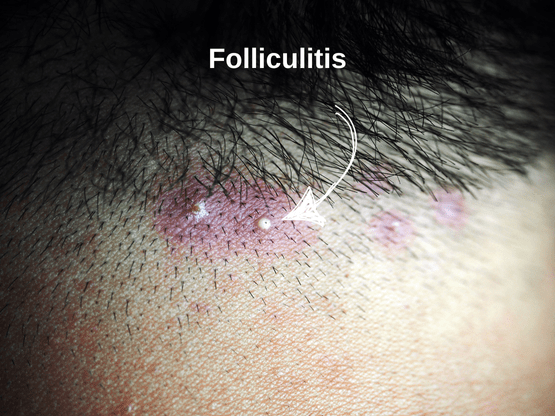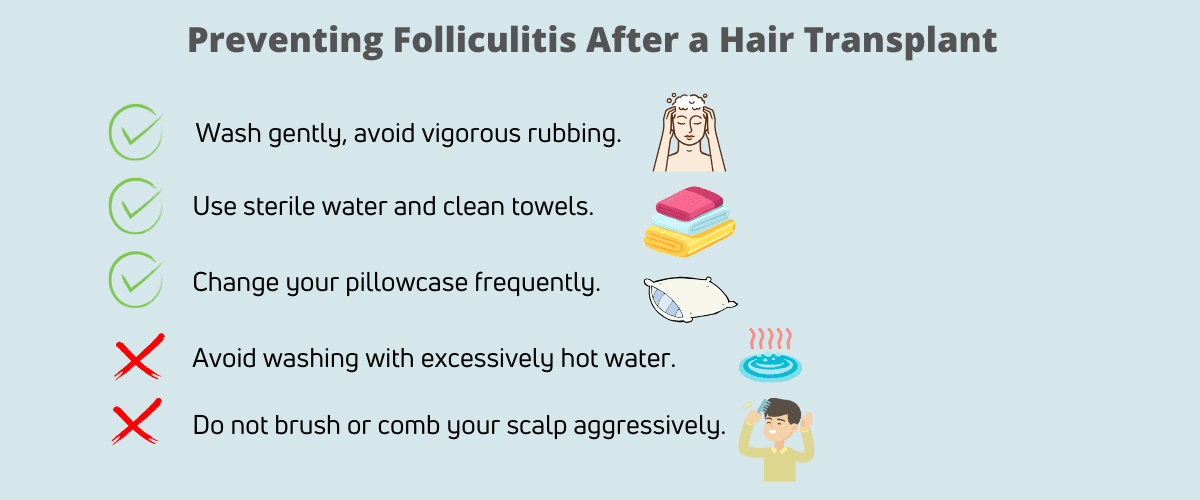Treating Folliculitis After a Hair Transplant

Folliculitis after a hair transplant is a common yet manageable issue that some patients experience during recovery. It appears as red, inflamed bumps around newly transplanted hair follicles, sometimes causing itching or discomfort.
While this condition is usually mild and temporary, ignoring it can slow healing or, in rare cases, affect hair growth. The good news? With proper aftercare and timely treatment, you can keep it under control and get back on track with your hair restoration journey.
What Is Folliculitis?
Folliculitis is the inflammation of hair follicles, usually caused by bacteria, irritation, or clogged pores. It often looks like small red or white-headed bumps that can be itchy or tender.
After a hair transplant, folliculitis can develop due to minor infections, trapped hairs, or even natural skin reactions during healing.
Most cases clear up on their own or with basic treatments, but in some situations, medical attention is needed to prevent complications.

Why Does Folliculitis Occur After Hair Transplantation?
Folliculitis can develop due to various factors during the healing process. Your scalp goes through a lot after a transplant, making it temporarily vulnerable. Some key reasons include:
-
Healing process disruptions: As new follicles settle in, some may become irritated or inflamed.
-
Blocked follicles: Dead skin, oil, or debris can clog follicles, leading to inflammation.
-
Bacterial infections: If bacteria enter tiny incisions, it can trigger an infection.
-
Skin sensitivity: Some skin types react more aggressively to post-surgical changes.
Why Is Timely Treatment for Folliculitis Important?
Treating folliculitis early prevents infection from spreading and helps protect the newly transplanted hair.
Most patients with folliculitis recover well and achieve satisfactory results within 12 months.
However, in rare cases, untreated folliculitis can lead to delayed or inhibited hair growth.
A few inflamed follicles here and there aren’t usually a problem.
But if redness, swelling, or discomfort keep increasing, it’s time to act. Quick treatment reduces irritation, speeds up healing, and keeps your new hair follicles safe.
What Causes Folliculitis After a Hair Transplant?
Folliculitis can happen for several reasons, ranging from normal healing reactions to improper aftercare. Let’s break down the most common causes:
Role of Post-Transplant Healing in Folliculitis Development
After a transplant, the scalp adjusts to newly implanted follicles. These follicles go through a "settling in" phase, and during this time, minor inflammation is normal.
However, if tiny scabs or crusts block hair growth or if the scalp reacts strongly to the procedure, folliculitis can develop.
Your body is essentially treating these new follicles like guests—it just needs time to adjust. But sometimes, the adjustment phase comes with irritation, especially if the immune system is on high alert.
Hygiene Issues and Folliculitis Risks
Not keeping the scalp clean can invite bacteria to settle in, increasing the risk of infection. But over-washing or scrubbing too hard can also irritate healing follicles.
A good aftercare routine includes gentle cleansing with a mild shampoo recommended by our doctors and team. Skipping this step—or using products that are too harsh—can create the perfect environment for folliculitis.
Ensuring the hygiene of both the donor area and the hair transplantation area is crucial to prevent folliculitis.
We recommend that our patients change their pillowcases and sheets frequently when they return to their home countries, as these are the surfaces their scalp comes into the most contact with. Additionally, they should take care to ensure that the donor area does not come into direct contact with the airplane seat during their flight from Antalya.
Prof. Dr. Ümit Kemal Şentürk - DK Klinik
Use of Non-Sterile Products or Improper Aftercare
Some patients unknowingly use non-sterile water, unapproved creams, or hair products too soon after the procedure. Anything that clogs follicles, introduces bacteria, or disrupts healing can lead to folliculitis.
Following your clinic’s aftercare instructions isn’t just a suggestion—it’s what keeps your scalp in the best condition to support new hair growth.
Skin Types Prone to Folliculitis
Certain skin types are naturally more likely to develop folliculitis. People with very curly hair, Afro-textured hair, or acne-prone skin may be at a higher risk.
If you fall into one of these categories, your clinic may recommend closer follow-ups or additional care tips to prevent any complications.
Signs of Folliculitis That Require Immediate Attention
Mild folliculitis often clears up with proper aftercare, but certain symptoms should never be ignored. If you notice any of the following, reach out to our doctors and team as soon as possible:
-
Persistent pain or discomfort that doesn’t improve.
-
Swelling that spreads beyond the transplant area.
-
Pus-filled bumps or cysts that keep getting worse.
-
Fever or signs of systemic infection, such as chills or fatigue.
Ignoring these symptoms can delay recovery or lead to scarring, so it’s always better to check in with us if something feels off.
Remedies for Treating Folliculitis After a Hair Transplant
Mild folliculitis often clears up on its own, but when irritation persists, the right care can help speed up recovery. Making small adjustments to your routine and using the right treatments can keep your scalp healthy and support new hair growth.
Preventive Measures to Avoid Folliculitis
Preventing folliculitis starts with simple but effective habits. Keeping the scalp clean with a mild, doctor-recommended shampoo helps remove excess oil and bacteria without irritating healing follicles.
Instead of rubbing, gently patting the scalp dry prevents unnecessary friction.
Sweating in the early weeks can also increase the risk of irritation.
Strenuous workouts, hot showers, and prolonged sun exposure create a warm, moist environment where bacteria thrive. If sweating occurs, dabbing the scalp with a clean, damp cloth can help keep irritation under control.

Over-the-Counter Treatments for Mild Folliculitis
For mild cases, some pharmacy-bought treatments can help soothe the scalp and prevent further irritation:
-
Topical antibiotics like mupirocin or clindamycin fight mild bacterial infections and reduce inflammation.
-
Anti-inflammatory creams containing mild corticosteroids, zinc, or aloe vera can calm redness and swelling.
-
Antibacterial shampoos help cleanse the scalp while preventing bacteria buildup.
-
Gentle exfoliation (only if recommended by our doctors and team) can help remove clogged debris that may be causing irritation.
Before trying any new treatment, it’s always best to check in with our team to make sure it’s safe for your scalp.
Professional Medical Interventions
If folliculitis becomes severe or doesn’t improve with basic treatments, professional care may be needed.
For deeper bacterial infections, our doctors may prescribe oral antibiotics like doxycycline or cephalexin to clear things up.
If inflammation becomes persistent, steroid-based creams or injections might be recommended to bring it under control.
These treatments should always be used under medical supervision to avoid unwanted side effects.
Natural Remedies for Mild Irritations
Some natural ingredients can help soothe irritation and reduce bacteria when used correctly:
-
Aloe vera is known for its calming and moisturizing properties. Applying pure aloe gel can help ease redness and promote healing.
-
Tea tree oil has antibacterial properties but should always be diluted before use. Mixing a few drops with a carrier oil like coconut oil can provide relief, but those with sensitive skin should test it on a small patch first to avoid irritation.
Long-Term Management of Skin Health After a Hair Transplant
Taking care of your scalp doesn’t stop once folliculitis clears up. Healthy habits can help prevent future irritation and keep your hair growing strong.
Choosing the Right Shampoos and Cleansers
Not all shampoos work well for a healing scalp. Using sulfate-free, antibacterial, or medicated shampoos can help keep bacteria in check without stripping away moisture. Our doctors and team can recommend the best shampoo for your specific scalp type to maintain long-term scalp health.
Maintaining a Balanced Diet for Skin Health
What you eat plays a big role in scalp health. Foods rich in vitamins A, C, and E support healing and help prevent inflammation. Staying hydrated and avoiding processed foods can also reduce the chances of scalp irritation and promote healthier hair growth.
When to Reach Out to Our Doctors and Team
If folliculitis keeps coming back or isn’t improving, it’s time to check in with us. Persistent irritation could mean there’s an underlying issue—like an allergic reaction or improper healing—that needs attention. Our team can assess your scalp, provide solutions, and guide you toward the best treatment to keep your hair transplant results on track.
Conclusion: Ensuring Healthy Recovery After a Hair Transplant
Folliculitis after a hair transplant is common, but with the right care, it’s manageable. Keeping your scalp clean, recognizing early signs of irritation, and using the proper treatments can help prevent complications and support healthy hair growth.
Staying in touch with our doctors and team ensures that any concerns are addressed early. If you experience persistent redness, swelling, or discomfort, seeking guidance promptly can make a big difference in your recovery.
A little extra care during the healing process helps protect your results and sets the foundation for strong, natural hair growth.
FAQs
How common is folliculitis after a hair transplant?
Folliculitis affects a small percentage of hair transplant patients—about 1%, according to some studies.
However, some studies have reported that folliculitis occurs in 20 out of 100 patients who undergo hair transplantation.
The significant variation between studies can be attributed to factors such as patient age, racial predisposition, and hygiene habits in different societies.
Based on our clinical observations, we see folliculitis in approximately 5% of our patients, but it resolves completely with the short treatment we recommend.
Therefore, if you notice acne-like lesions on your scalp, you should contact your dermatologist.
While it’s not something everyone experiences, it’s still important to know the signs so you can address it quickly if it does happen.
Can folliculitis damage my transplanted hair?
In most cases, folliculitis doesn’t cause lasting damage to the transplanted hair. Studies show that most patients with folliculitis still achieve good results after 12 months.
However, if left untreated, severe cases could lead to scarring or delayed hair growth.
What are the first signs of folliculitis after a transplant?
The earliest signs include small red bumps, mild itching, and localized redness around the transplanted follicles.
If these symptoms worsen or become painful, it could indicate a bacterial infection that needs attention.
Is it safe to apply topical antibiotics without consulting my surgeon?
It’s best to check with your clinic first. While some over-the-counter antibiotics like mupirocin can help with mild cases, using the wrong product—or applying it incorrectly—could irritate the scalp further or interfere with healing.
How long does it take for folliculitis to resolve?
Mild cases usually clear up within a week or two with proper care. More persistent cases may take a few weeks, especially if antibiotics or prescription treatments are needed. If it lingers beyond this, it’s a good idea to follow up with your doctor.
Are there natural remedies for treating folliculitis?
Yes, but they should be used with caution. Aloe vera can help soothe irritation, while diluted tea tree oil has antibacterial properties.
However, it’s important to avoid harsh DIY treatments that could irritate the sensitive transplant area.
How can I prevent folliculitis after my hair transplant?
-
Keep your scalp clean but avoid over-washing.
-
Follow all post-transplant care instructions provided by your clinic.
-
Avoid excessive sweating in the early healing phase.
-
Choose an experienced team for your procedure to reduce the risk of poorly placed grafts or infections.
When should I see a doctor for folliculitis?
If the bumps become painful, spread, or start oozing pus, it’s time to seek medical advice. Symptoms like fever or increasing redness beyond the transplant area may indicate an infection that requires treatment.
Can I continue using my regular shampoo if I develop folliculitis?
It depends. Some shampoos contain harsh ingredients that may worsen irritation. Send us photos via WhatsApp, and we’ll review your case to recommend the best shampoo for your scalp.

